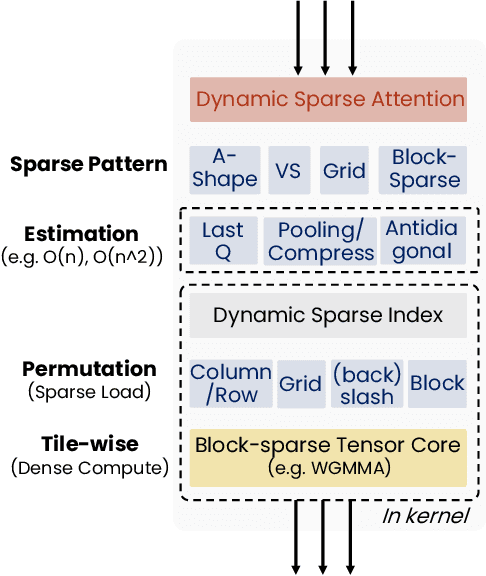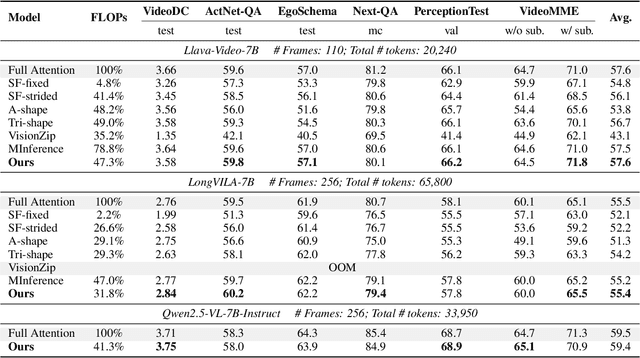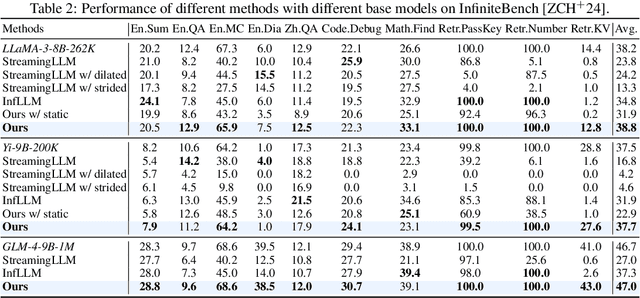Qianhui Wu
Dyna-Mind: Learning to Simulate from Experience for Better AI Agents
Oct 10, 2025Abstract:Reasoning models have recently shown remarkable progress in domains such as math and coding. However, their expert-level abilities in math and coding contrast sharply with their performance in long-horizon, interactive tasks such as web navigation and computer/phone-use. Inspired by literature on human cognition, we argue that current AI agents need ''vicarious trial and error'' - the capacity to mentally simulate alternative futures before acting - in order to enhance their understanding and performance in complex interactive environments. We introduce Dyna-Mind, a two-stage training framework that explicitly teaches (V)LM agents to integrate such simulation into their reasoning. In stage 1, we introduce Reasoning with Simulations (ReSim), which trains the agent to generate structured reasoning traces from expanded search trees built from real experience gathered through environment interactions. ReSim thus grounds the agent's reasoning in faithful world dynamics and equips it with the ability to anticipate future states in its reasoning. In stage 2, we propose Dyna-GRPO, an online reinforcement learning method to further strengthen the agent's simulation and decision-making ability by using both outcome rewards and intermediate states as feedback from real rollouts. Experiments on two synthetic benchmarks (Sokoban and ALFWorld) and one realistic benchmark (AndroidWorld) demonstrate that (1) ReSim effectively infuses simulation ability into AI agents, and (2) Dyna-GRPO leverages outcome and interaction-level signals to learn better policies for long-horizon, planning-intensive tasks. Together, these results highlight the central role of simulation in enabling AI agents to reason, plan, and act more effectively in the ever more challenging environments.
MMInference: Accelerating Pre-filling for Long-Context VLMs via Modality-Aware Permutation Sparse Attention
Apr 22, 2025



Abstract:The integration of long-context capabilities with visual understanding unlocks unprecedented potential for Vision Language Models (VLMs). However, the quadratic attention complexity during the pre-filling phase remains a significant obstacle to real-world deployment. To overcome this limitation, we introduce MMInference (Multimodality Million tokens Inference), a dynamic sparse attention method that accelerates the prefilling stage for long-context multi-modal inputs. First, our analysis reveals that the temporal and spatial locality of video input leads to a unique sparse pattern, the Grid pattern. Simultaneously, VLMs exhibit markedly different sparse distributions across different modalities. We introduce a permutation-based method to leverage the unique Grid pattern and handle modality boundary issues. By offline search the optimal sparse patterns for each head, MMInference constructs the sparse distribution dynamically based on the input. We also provide optimized GPU kernels for efficient sparse computations. Notably, MMInference integrates seamlessly into existing VLM pipelines without any model modifications or fine-tuning. Experiments on multi-modal benchmarks-including Video QA, Captioning, VisionNIAH, and Mixed-Modality NIAH-with state-of-the-art long-context VLMs (LongVila, LlavaVideo, VideoChat-Flash, Qwen2.5-VL) show that MMInference accelerates the pre-filling stage by up to 8.3x at 1M tokens while maintaining accuracy. Our code is available at https://aka.ms/MMInference.
Magma: A Foundation Model for Multimodal AI Agents
Feb 18, 2025Abstract:We present Magma, a foundation model that serves multimodal AI agentic tasks in both the digital and physical worlds. Magma is a significant extension of vision-language (VL) models in that it not only retains the VL understanding ability (verbal intelligence) of the latter, but is also equipped with the ability to plan and act in the visual-spatial world (spatial-temporal intelligence) and complete agentic tasks ranging from UI navigation to robot manipulation. To endow the agentic capabilities, Magma is pretrained on large amounts of heterogeneous datasets spanning from images, videos to robotics data, where the actionable visual objects (e.g., clickable buttons in GUI) in images are labeled by Set-of-Mark (SoM) for action grounding, and the object movements (e.g., the trace of human hands or robotic arms) in videos are labeled by Trace-of-Mark (ToM) for action planning. Extensive experiments show that SoM and ToM reach great synergy and facilitate the acquisition of spatial-temporal intelligence for our Magma model, which is fundamental to a wide range of tasks as shown in Fig.1. In particular, Magma creates new state-of-the-art results on UI navigation and robotic manipulation tasks, outperforming previous models that are specifically tailored to these tasks. On image and video-related multimodal tasks, Magma also compares favorably to popular large multimodal models that are trained on much larger datasets. We make our model and code public for reproducibility at https://microsoft.github.io/Magma.
On Memory Construction and Retrieval for Personalized Conversational Agents
Feb 08, 2025Abstract:To deliver coherent and personalized experiences in long-term conversations, existing approaches typically perform retrieval augmented response generation by constructing memory banks from conversation history at either the turn-level, session-level, or through summarization techniques. In this paper, we present two key findings: (1) The granularity of memory unit matters: Turn-level, session-level, and summarization-based methods each exhibit limitations in both memory retrieval accuracy and the semantic quality of the retrieved content. (2) Prompt compression methods, such as \textit{LLMLingua-2}, can effectively serve as a denoising mechanism, enhancing memory retrieval accuracy across different granularities. Building on these insights, we propose SeCom, a method that constructs a memory bank with topical segments by introducing a conversation Segmentation model, while performing memory retrieval based on Compressed memory units. Experimental results show that SeCom outperforms turn-level, session-level, and several summarization-based methods on long-term conversation benchmarks such as LOCOMO and Long-MT-Bench+. Additionally, the proposed conversation segmentation method demonstrates superior performance on dialogue segmentation datasets such as DialSeg711, TIAGE, and SuperDialSeg.
SCBench: A KV Cache-Centric Analysis of Long-Context Methods
Dec 13, 2024



Abstract:Long-context LLMs have enabled numerous downstream applications but also introduced significant challenges related to computational and memory efficiency. To address these challenges, optimizations for long-context inference have been developed, centered around the KV cache. However, existing benchmarks often evaluate in single-request, neglecting the full lifecycle of the KV cache in real-world use. This oversight is particularly critical, as KV cache reuse has become widely adopted in LLMs inference frameworks, such as vLLM and SGLang, as well as by LLM providers, including OpenAI, Microsoft, Google, and Anthropic. To address this gap, we introduce SCBench(SharedContextBench), a comprehensive benchmark for evaluating long-context methods from a KV cachecentric perspective: 1) KV cache generation, 2) KV cache compression, 3) KV cache retrieval, 4) KV cache loading. Specifically, SCBench uses test examples with shared context, ranging 12 tasks with two shared context modes, covering four categories of long-context capabilities: string retrieval, semantic retrieval, global information, and multi-task. With it, we provide an extensive KV cache-centric analysis of eight categories long-context solutions, including Gated Linear RNNs, Mamba-Attention hybrids, and efficient methods such as sparse attention, KV cache dropping, quantization, retrieval, loading, and prompt compression. The evaluation is conducted on 8 long-context LLMs. Our findings show that sub-O(n) memory methods suffer in multi-turn scenarios, while sparse encoding with O(n) memory and sub-O(n^2) pre-filling computation perform robustly. Dynamic sparsity yields more expressive KV caches than static patterns, and layer-level sparsity in hybrid architectures reduces memory usage with strong performance. Additionally, we identify attention distribution shift issues in long-generation scenarios. https://aka.ms/SCBench.
MInference 1.0: Accelerating Pre-filling for Long-Context LLMs via Dynamic Sparse Attention
Jul 02, 2024



Abstract:The computational challenges of Large Language Model (LLM) inference remain a significant barrier to their widespread deployment, especially as prompt lengths continue to increase. Due to the quadratic complexity of the attention computation, it takes 30 minutes for an 8B LLM to process a prompt of 1M tokens (i.e., the pre-filling stage) on a single A100 GPU. Existing methods for speeding up prefilling often fail to maintain acceptable accuracy or efficiency when applied to long-context LLMs. To address this gap, we introduce MInference (Milliontokens Inference), a sparse calculation method designed to accelerate pre-filling of long-sequence processing. Specifically, we identify three unique patterns in long-context attention matrices-the A-shape, Vertical-Slash, and Block-Sparsethat can be leveraged for efficient sparse computation on GPUs. We determine the optimal pattern for each attention head offline and dynamically build sparse indices based on the assigned pattern during inference. With the pattern and sparse indices, we perform efficient sparse attention calculations via our optimized GPU kernels to significantly reduce the latency in the pre-filling stage of long-context LLMs. Our proposed technique can be directly applied to existing LLMs without any modifications to the pre-training setup or additional fine-tuning. By evaluating on a wide range of downstream tasks, including InfiniteBench, RULER, PG-19, and Needle In A Haystack, and models including LLaMA-3-1M, GLM4-1M, Yi-200K, Phi-3-128K, and Qwen2-128K, we demonstrate that MInference effectively reduces inference latency by up to 10x for pre-filling on an A100, while maintaining accuracy. Our code is available at https://aka.ms/MInference.
Mitigate Position Bias in Large Language Models via Scaling a Single Dimension
Jun 04, 2024



Abstract:Large Language Models (LLMs) are increasingly applied in various real-world scenarios due to their excellent generalization capabilities and robust generative abilities. However, they exhibit position bias, also known as "lost in the middle", a phenomenon that is especially pronounced in long-context scenarios, which indicates the placement of the key information in different positions of a prompt can significantly affect accuracy. This paper first explores the micro-level manifestations of position bias, concluding that attention weights are a micro-level expression of position bias. It further identifies that, in addition to position embeddings, causal attention mask also contributes to position bias by creating position-specific hidden states. Based on these insights, we propose a method to mitigate position bias by scaling this positional hidden states. Experiments on the NaturalQuestions Multi-document QA, KV retrieval, LongBench and timeline reorder tasks, using various models including RoPE models, context windowextended models, and Alibi models, demonstrate the effectiveness and generalizability of our approach. Our method can improve performance by up to 15.2% by modifying just one dimension of hidden states. Our code is available at https://aka.ms/PositionalHidden.
LLMLingua-2: Data Distillation for Efficient and Faithful Task-Agnostic Prompt Compression
Mar 19, 2024



Abstract:This paper focuses on task-agnostic prompt compression for better generalizability and efficiency. Considering the redundancy in natural language, existing approaches compress prompts by removing tokens or lexical units according to their information entropy obtained from a causal language model such as LLaMa-7B. The challenge is that information entropy may be a suboptimal compression metric: (i) it only leverages unidirectional context and may fail to capture all essential information needed for prompt compression; (ii) it is not aligned with the prompt compression objective. To address these issues, we propose a data distillation procedure to derive knowledge from an LLM to compress prompts without losing crucial information, and meantime, introduce an extractive text compression dataset. We formulate prompt compression as a token classification problem to guarantee the faithfulness of the compressed prompt to the original one, and use a Transformer encoder as the base architecture to capture all essential information for prompt compression from the full bidirectional context. Our approach leads to lower latency by explicitly learning the compression objective with smaller models such as XLM-RoBERTa-large and mBERT. We evaluate our method on both in-domain and out-of-domain datasets, including MeetingBank, LongBench, ZeroScrolls, GSM8K, and BBH. Despite its small size, our model shows significant performance gains over strong baselines and demonstrates robust generalization ability across different LLMs. Additionally, our model is 3x-6x faster than existing prompt compression methods, while accelerating the end-to-end latency by 1.6x-2.9x with compression ratios of 2x-5x.
LongLLMLingua: Accelerating and Enhancing LLMs in Long Context Scenarios via Prompt Compression
Oct 10, 2023Abstract:In long context scenarios, large language models (LLMs) face three main challenges: higher computational/financial cost, longer latency, and inferior performance. Some studies reveal that the performance of LLMs depends on both the density and the position of the key information (question relevant) in the input prompt. Inspired by these findings, we propose LongLLMLingua for prompt compression towards improving LLMs' perception of the key information to simultaneously address the three challenges. We conduct evaluation on a wide range of long context scenarios including single-/multi-document QA, few-shot learning, summarization, synthetic tasks, and code completion. The experimental results show that LongLLMLingua compressed prompt can derive higher performance with much less cost. The latency of the end-to-end system is also reduced. For example, on NaturalQuestions benchmark, LongLLMLingua gains a performance boost of up to 17.1% over the original prompt with ~4x fewer tokens as input to GPT-3.5-Turbo. It can derive cost savings of \$28.5 and \$27.4 per 1,000 samples from the LongBench and ZeroScrolls benchmark, respectively. Additionally, when compressing prompts of ~10k tokens at a compression rate of 2x-10x, LongLLMLingua can speed up the end-to-end latency by 1.4x-3.8x. Our code is available at https://aka.ms/LLMLingua.
LLMLingua: Compressing Prompts for Accelerated Inference of Large Language Models
Oct 09, 2023Abstract:Large language models (LLMs) have been applied in various applications due to their astonishing capabilities. With advancements in technologies such as chain-of-thought (CoT) prompting and in-context learning (ICL), the prompts fed to LLMs are becoming increasingly lengthy, even exceeding tens of thousands of tokens. To accelerate model inference and reduce cost, this paper presents LLMLingua, a coarse-to-fine prompt compression method that involves a budget controller to maintain semantic integrity under high compression ratios, a token-level iterative compression algorithm to better model the interdependence between compressed contents, and an instruction tuning based method for distribution alignment between language models. We conduct experiments and analysis over four datasets from different scenarios, i.e., GSM8K, BBH, ShareGPT, and Arxiv-March23; showing that the proposed approach yields state-of-the-art performance and allows for up to 20x compression with little performance loss. Our code is available at https://aka.ms/LLMLingua.
 Add to Chrome
Add to Chrome Add to Firefox
Add to Firefox Add to Edge
Add to Edge